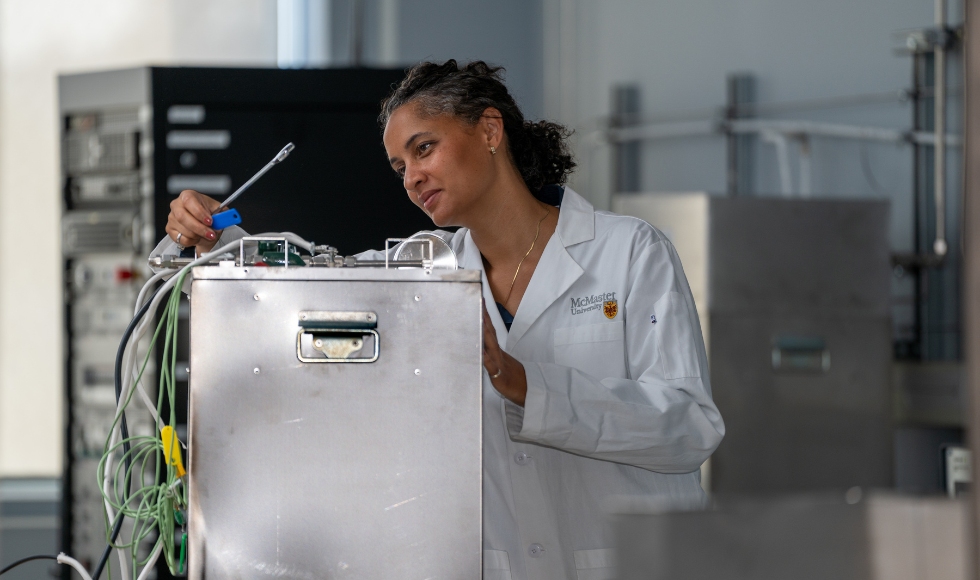Sustainable energy and the promise of metal-water reactors

Keena Trowell, a professor of mechanical engineering, is tackling the big question of how we can easily store and transport renewable energy so it can get to communities in need.
BY Beth Gallagher
October 17, 2024
Keena Trowell left her career as a designer when she realized that she wanted to do more than simply help clients make more sustainable choices in their homes and businesses.
“It turns out that individual lifestyle choices are not enough to solve the climate crisis,” says Trowell, now an assistant professor of mechanical engineering. “What we need are big shifts in how we power things.”
So, when Trowell pivoted to engineering, she searched for a way to solve a fundamental question: How do we take renewable energy and make it in a way that we can easily move it around?
For instance, hydrogen is a clean fuel, but it hasn’t been widely adopted because it’s also highly flammable and has a low-energy density, which means it requires costly, complex infrastructure to transport.
Trowell, who “really wanted to get in on the ground floor of something new,” landed on metal-water reactions as a promising way of reducing greenhouse gas emissions while powering remote communities with renewable energy.
Breakthrough research on water-metal reactions
In 2022, Trowell became the first in the world to publish results that showed hydrogen and heat are produced, without the addition of a catalyst, when metals are combined with supercritical water — a state water reaches at a very high temperature and pressure inside a reactor.
Using aluminum, which is energy-dense, abundant, recyclable and safe under normal conditions in a metal-water reaction could produce the clean fuel where it’s needed.
“Aluminum lasts for an extremely long time and doesn’t need any special storage conditions,” says Trowell. “So, if you couple aluminum with an aluminum-water reactor, a community can produce heat and hydrogen on demand.”
Circular system: metal fuels also minimize waste
Once the hydrogen and heat have been produced, the non-toxic aluminum oxide powder left behind can be easily captured and fully recycled back to the original metal using carbon-free processes.
“Capturing the oxides is the key to the circular fuel system,” says Trowell. “That powder is the beginning of this whole cycle starting over again. We can take the powder and make new aluminum out of it.”
Circular fuel systems produce fuel with minimal waste by reusing and recycling materials, explains Trowell. These closed-loop processes are good for the planet.
From the lab to marketplace
Trowell and her team at McMaster are focused on building partnerships. “We’re standing at the edge right now. We’ve proven the theory in the lab and now we want to prototype and scale up – take it from the lab to the marketplace.”
In a recent paper, Trowell argues that metal fuels could be part of Canada’s solution to decarbonizing its energy supply and could be traded on the global energy market as oil, coal and natural gas are traded today.
In another paper, Trowell shows how aluminum is affordable to produce and safe to store and transport.
Trowell, a member of the McMaster Institute for Energy Studies, said she joined the Faculty of Engineering in 2022 because it was a good place to advance her research. “There is a lot of really exciting work being done here in the energy space. McMaster is a leader in SMR [small modular reactor] research, and I saw that I could complement what was being done here … this whole area around metal fuels and transporting energy and long duration energy storage.”
Her colleague Jim Cotton’s leadership on thermal energy networks is of particular interest to Trowell. Cotton, a professor of mechanical engineering, is also the founder of HARvEST, a company that has commercialized technology to harvest and recycle waste heat in the restaurant industry.
It was an innovative geothermal heating system Trowell noticed while working as a designer that first sparked her interest in energy systems and the impact she could make in engineering. Today, Trowell can envision a future for Canada to emerge as a leader in clean energy systems, leading the trade in clean power using metals.
She hopes metal-water reaction technology can one day be used in industry and communities that currently don’t have enough energy to meet basic needs. Almost 1 billion people rely on health-care facilities that have either no electricity or unreliable electricity.
“In Canada, we know the lights will be on when we go to the hospital. If our loved one needs surgery, there’s going to be electricity,” says Trowell. “This is still not true for a lot of people around the world.”


